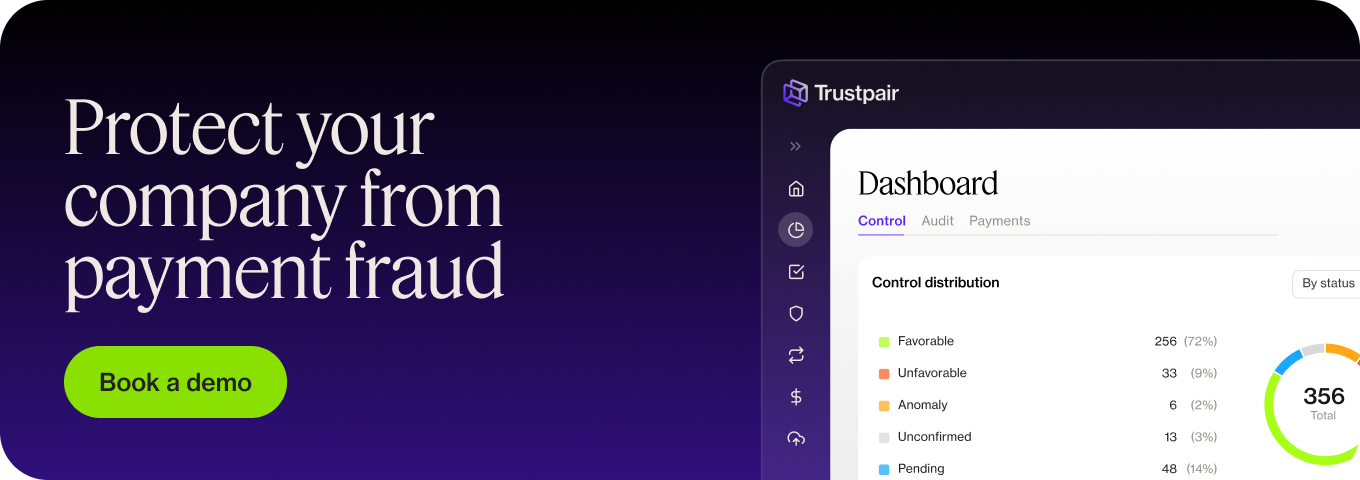With a staggering 96% of US companies targeted by fraud at least once in 2023, it seems that payment fraud is here to stay. More sophisticated and harder to detect, fraud has taken its toll on businesses: not only financially but also through considerable reputational damages. Baptiste Collot, CEO of Trustpair gives us his thoughts and advice to fend off the threats effectively.
To get more details and numbers about 2024 fraud trends, download our full 2024 fraud report!
- Do think that the increase in cyberattacks impacts the average amount lost in fraud? FYI, 83% of companies targeted by fraud were targeted by cyber fraud & 36% of companies victims of fraud lost more than 1 million dollars.
Baptiste: Cyber Fraud is more complex to identify and goes undetected longer. Which makes the amounts lost bigger. Also, people often trust digital payments and notice less when something odd happens: they’re more confident, but they shouldn’t be.
People feel more confident when they receive information through digital means. Especially when it comes from channels they know: from a known vendor for example. They’ll be less suspicious than if it comes with a weird phone call.
- Do you have any real-life examples of cyber fraud?
Baptiste: Of course. A client’s vendor gets hacked, and his email gets hacked. The fraudsters send by email a request for a change of banking information to buyers. Our client pays the next 2 invoices to the fraudsters. And then, there’s a new request for a change in banking information. But this one is real.
The fraud took a very long time to be detected: payments went back to normal after a few occurrences. So the vendor just thought “That’s odd, there are a few late payments but they’ll get here soon”, and in fact they did.
So that’s a good example of cyber fraud that targeted the vendor – and his email server – but caused harm to the buying company.
- That’s interesting: I imagine that in this case, the impact wasn’t only financial. But there were other impacts?
There was a trial. Our client blamed his vendor, saying that in the end, the fake information came from its’ email servers. So our client said it was up to the vendor to double-check information and that they were responsible for checking the information that came out of their email servers was legit.
So these two companies that were so close and had worked together for many years ended up in court. Obviously, it has a huge impact on supplier relationships.
- What about the impact on stock price?
Baptiste: It depends on the amount lost, but it is rare to lose so much as to impact stocks. However, it can definitely have an impact on reputation and image, which at length can have an impact on company value.
- In terms of payment methods used for fraud: last year there was a big part of fraud came from paper checks. This was less the case this year. Could you explain why going from paper checks to e-payment is an opportunity for fraudsters?
Going from paper checks to e-payment means setting up a new vendor database. And that means there’s suddenly a new need to control all this vendor data and a new need for specific processes. If there isn’t a process to control all this new banking information, there’s a risk for each new vendor. It’s the massive amount of new data that represents a risk for the company.
- What we also see in the study is that training is still a massive answer to fraud. The shift to automation isn’t happening quickly enough. Why is that? What are the main blockers?
For me, there’s a real lack of awareness of what exists on the market. There’s also a question of bandwidth and prioritization of this specific project vs the other projects. Digital transformation is already costly in terms of budget and resources: companies don’t have the resources to invest in fraud prevention software.
- A small question to conclude. This is the third or fourth year we’re doing this study. What’s your overall vision and impressions of fraud? What has changed in these last few years?
I think fraud is now completely in a standardized and digital era.
It’s been evolving and becoming more and more digital. We’ve seen the shift from manual to digital fraud: and now it’s done. Fraud is an industry. A mature and equipped industry, with specialized organizations.
If you want to wipe out payment fraud in your business, request a demo!






